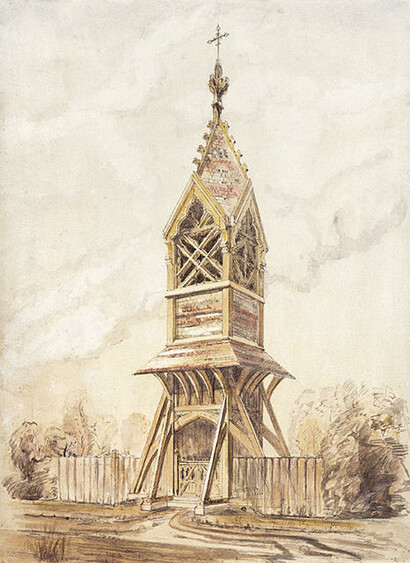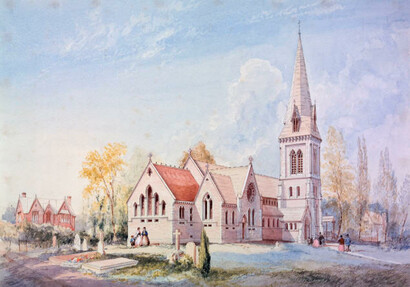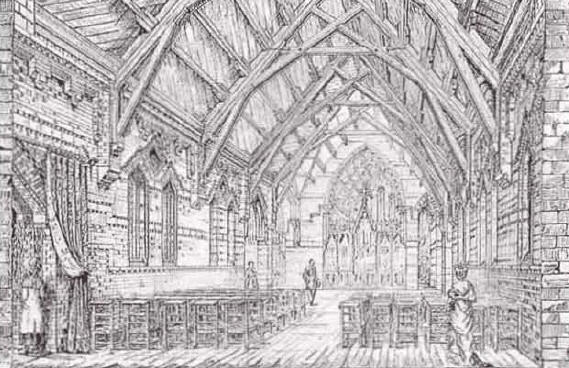This exhibition is now closed
B.W. Mountfort and the Gothic Revival: A Centennial Exhibition
17 September –
22 November 1998

This year marked the centennial of the death of Christchurch and New Zealand's most distinguished Victorian architect, Benjamin Woolfield Mountfort (1825‒1898). The anniversary was marked by a commemorative service in Christchurch Cathedral and the unveiling of a plaque in the Great Hall of the Arts Centre. The Robert McDougall Art Gallery is also commemorating the centennial with an ambitious exhibition which will include architectural drawings, decorative arts, books from Mountfort's personal library and historic photographs of buildings he designed.
Mountfort's achievements are worth celebrating because it was he who did most to shape the architectural character of nineteenth-century Christchurch. When the Canterbury Pilgrims arrived on 16 December 1850 Mountfort was one of the first settlers ashore and he lived and worked in Canterbury, first in Lyttelton, then from 1857, in Christchurch, for the rest of his life. As an architect he designed most of the public buildings which give Christchurch its distinctive Gothic Revival character. Pre-eminent among these are the Canterbury Provincial Council Buildings, built between 1858 and 1865, but almost equally important are the Museum (1869‒82) and Canterbury College, on which he worked for twenty years from 1876 until 1896. Other projects, such as a Supreme Court design with a spectacular free-standing tower (dating from 1867) remained unbuilt. These buildings will all be represented in the exhibition through Mountfort's architectural drawings, historic photographs and items of furniture.
Mountfort is, however, best known as a designer of churches and this aspect of his work will form a central focus of the exhibition, ranging from plans for modest country parish churches built of wood to designs for cathedrals in brick and stone. Because of its central place in the city, Christchurch Cathedral is accorded particular prominence in the exhibition. Although designed by the eminent English architect, Sir George Gilbert Scott, Mountfort was the supervising architect from 1873 and was responsible for the design of the spire and many of the Cathedral's furnishings, including the pulpit and font. The exhibition will include drawings by Scott for the Cathedral never seen in public before as well as designs by Mountfort for stained glass and other furnishings. Highlights will include Bishop Harper's throne and crozier, the latter designed by Mountfort and presented to the Bishop in 1875 in the precinct of the unfinished cathedral.
An aspect of the exhibition which visitors will find particularly revealing are the plans which Mountfort completed before he emigrated to New Zealand. These designs, which have never been exhibited before, are mostly for churches and reveal the architect's sophisticated knowledge of advanced contemporary ideas about church design, particularly his knowledge of the publications of A.W.N. Pugin and the Cambridge Camden (later the Ecclesiological) Society. Closely related to these works are Mountfort's own copies of two of Pugin's most influential books, The True Principles of Christian or Pointed Architecture (1841) and An Apology for the Revival of Christian Architecture (1843), both acquired in the year of publication. Formerly in the library of the distinguished New Zealand architect, W.H. Gummer, these handsome books reveal that Mountfort had surrendered to Pugin's influence by the age of 16.
Architectural exhibitions present particular problems for curators, conservators and exhibition designers. First of all, the real works of art, the buildings themselves, are absent.
They must be represented by other means, whether these are the architect's own drawings, artists' renderings or photographs. Because architectural drawings have, until quite recently, been considered of only utilitarian value, they are often dirty and in poor repair. Once repaired and cleaned, as Mountfort's drawings have been for this exhibition, they reveal often surprising and subtle beauties. The drawings chosen for the exhibition include a broad sampling of drawing types from sketch designs to elaborate watercolour perspective views as well as drawings of timber joinery and stonework which demonstrate Mountfort's meticulous attention to the smallest details of his buildings.
Rather than trying to represent the full extent of Mountfort's works, the exhibition focuses on his most important projects as well as those which can be documented effectively through his own drawings. Like all such exhibitions, its content has been dictated by accidents of survival. Little more than 50 years ago the great majority of Mountfort's architectural drawings were homeless; today they are the treasured possession of the institutions which own them. Most of the drawings exhibited come from three Christchurch collections: the Canterbury Museum, the Christchurch Anglican Diocesan Archives, and the University of Canterbury's Architectural Drawings Collection. Additional drawings and objects have been loaned by the Christchurch City Council, Christ's College, the Christchurch Club, Christ Church Cathedral and the churches of St Michael and All Angels and Holy Trinity, Avonside. Funds for the conservation of drawings have been provided by the Community Trust.
Mountfort's buildings play an essential part in making Christchurch a rewarding city to live in, contributing to an urban character unique in Australasia. No other city in this part of the world can claim such a fine collection of High Victorian buildings. They also provide strong visual links with the city's past and of its origins in the idealistic vision of the Canterbury Association, the 150th anniversary of which we also commemorate in 1998.
Visitors to the exhibition will be able to admire the skills which went into the making of these designs, discover buildings they did not know and begin to appreciate hidden aspects of others they think they know well. The McDougall's Mountfort exhibition will run for a mere two months but its most important function is to enhance gallery visitors' appreciation and understanding of the ongoing Mountfort exhibition which opened in Christchurch over a century ago and which should still be open 100 years hence.
Ian Lochhead
This exhibition was held at the Robert McDougall Art Gallery in the Botanic Gardens.
Exhibition number: 649


